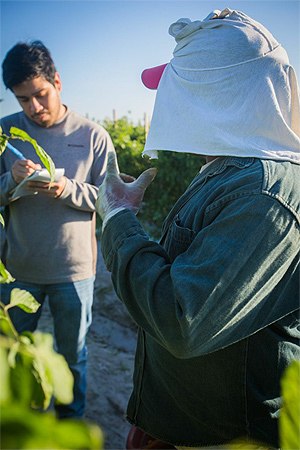[hupso title=”READ: See @FoodChainsFilm, speed the movement… @FairFoodProgram” url=”https://ciw-online.org/blog/2014/11/food-chains-harvest/”]
The seminal CBS Reports documentary “Harvest of Shame” (the Youtube version of which is embedded here, above) first aired on the day after Thanksgiving, 1960. In a time when the airwaves were dominated by only three networks, the Edward R. Murrow classic reached millions of Americans and shocked the nation, an effect that was very much intended. David Lowe, the documentary’s producer, told Time magazine:
“We felt that by scheduling the program the day after Thanksgiving, we could stress the fact that much of the food cooked for Thanksgiving throughout the country was picked by migratory workers. We hoped that the pictures of how these people live and work would shock the consciousness of the nation.”
Today, fifty four years later, a new documentary on farm labor, “Food Chains,” is in theaters across the country. And today, the day after Thanksgiving, you can see “Food Chains” at a theater near you or, if it isn’t at a local theater, through iTunes. What better way to remember that “much of the food cooked for Thanksgiving throughout the country was picked by migratory workers,” a message as relevant now as it was half a century ago?

“Food Chains’ picks up where ‘Harvest of Shame’ left off”
But if you do go to see “Food Chains,” don’t go under the impression that it is simply “Harvest of Shame” redux.
Indeed, in a recent op/ed in The Californian, Dennis Taylor, that paper’s agricultural reporter, wrote, “‘Food Chains’ picks up where ‘Harvest of Shame’ left off.” That’s because in 1960, when Edward R. Murrow took the nation on a tour of migrant labor camps and farm fields in Florida (“Harvest of Shame” was filmed largely in Florida farmworker communities, including Immokalee and Belle Glade), there was no solution to share with consumers, there was only the problem of endemic farmworker poverty and exploitation. And that problem was raw. One of the most telling quotes in Murrow’s report came from a grower, who boldly told the film crew, “We used to own our slaves; now we just rent them.”

Today, however, there is a solution. And while “Food Chains” does, like “Harvest of Shame” did before it, chronicle the ills still faced by the majority of this country’s farmworkers, it also tells the story of a powerful new program that is addressing farm labor abuse with unprecedented success — the CIW’s Fair Food Program.
And that’s exactly why it is so important that you go see “Food Chains” this holiday season, and that you make sure that your family and friends see it, too.
Today, the Fair Food Program is on the threshold of expansion to states beyond Florida and to crops outside of tomatoes. The transformation of the Florida tomato industry — from the backdrop of the “Harvest of Shame” into “probably the best working environment in American agriculture,” as it was called on the front page of the New York Times earlier this year — is nothing short of historic. But while 30,000 farmworkers in Florida are protected by what one longtime labor observer called “the best workplace monitoring program I’ve seen in the US,” many, many more workers across the country, and even here in Florida, still are not.
The greatest challenge facing the Fair Food Program today is not the reform of the Florida tomato industry. With the Program now entering its fourth season in effect on over 90% of Florida’s tomato fields, the industry stands as a model for 21st century labor relations in agriculture. Slavery and sexual violence have been eliminated, wage theft and other labor rights violations are now the rare exception rather than the rule, and when abuses do occur, workers have access to a fast and effective complaint investigation and resolution system to defend their rights.
Rather, the greatest challenge today for the Fair Food Program is the expansion of those new rights — and of the effective infrastructure of monitoring and enforcement necessary to guarantee those rights — to new fields and new crops. And to the degree that “Food Chains” works its way into the American consciousness, the expansion of the Fair Food Program will be made far, far easier.
“Intended to shock Americans into action…”
In his closing remarks, Edward R. Murrow intoned:
“The migrants have no lobby. Only an enlightened, aroused and perhaps angered public opinion can do anything about the migrants.”
In the words of an NPR story on the film from May of this year, “Harvest of Shame” was “intended to shock Americans into action.” And it did. “Harvest of Shame” has been credited with helping to “push forward legislation that was already pending in Congress, like funding for health services to migrant workers and education for migrants’ children.” Indeed, President Lyndon Johnson’s War on Poverty was launched in 1964 with memory of the film’s shocking images of farm labor degradation still fresh in the country’s collective memory.
Today, “Food Chains” is intended not to shock but to inspire Americans into action, action in support of the Campaign for Fair Food. We can no longer wait or hold out hope for legislation to help end farm labor exploitation in this country. Our political system is far too broken to produce any meaningful reforms for a sector as marginalized socially and economically as migrant farmworkers.
But we have proven — through the Campaign for Fair Food — that a forceful, energetic alliance of farmworkers and enlightened consumers can change working conditions for farmworkers through the worker-driven, market-based mechanisms of the Fair Food Program. “Food Chains” can help fuel that movement to grow, and grow stronger, from Florida to California.

“Food Chains” had a remarkable opening weekend, with sold-out shows, all-star panels, strong reviews, and Fair Food actions in more than a dozen cities across the country. But it’s what happens next that will truly determine “Food Chains'” ultimate impact.
The film opens today in eight new cities — including San Francisco, Denver, and Portland — and is being held over in Washington, DC, after playing to sold-out audiences there all last week. With the film hitting new theaters, many of them in cities with strong Fair Food committees, the Fair Food Nation has an opportunity to make farm labor and the Fair Food Program the topic of conversation at dinner tables across the country this holiday season.
And that is a conversation that is long overdue. While tens of millions of Americans are engaged in the growing discussion around food these days, the questions driving that discussion tend to focus on everything — is it local?, is it organic?, is it free range? — but the human story behind the food. In the words of best-selling author Eric Schlosser (“Fast-Food Nation”):
“[The food movement] too often ignores the people who feed us … who are less glamorous than celebrity chefs, but ultimately much more essential…” read more
“Food Chains” can help put the focus of the food movement where it needs to be, on the people, in the words of Jim Goodman of Family Farm Defenders, “who know what it’s like to soak your clothes with sweat in the fields.”
If you haven’t seen “Food Chains” yet, go see it this holiday season, and take your friends and family. Help spread the word about “one of the great human rights success stories of our day”. Help speed the movement to end this country’s “Harvest of Shame” once and for all, fifty four years after it first aired, the day after Thanksgiving, 1960.
